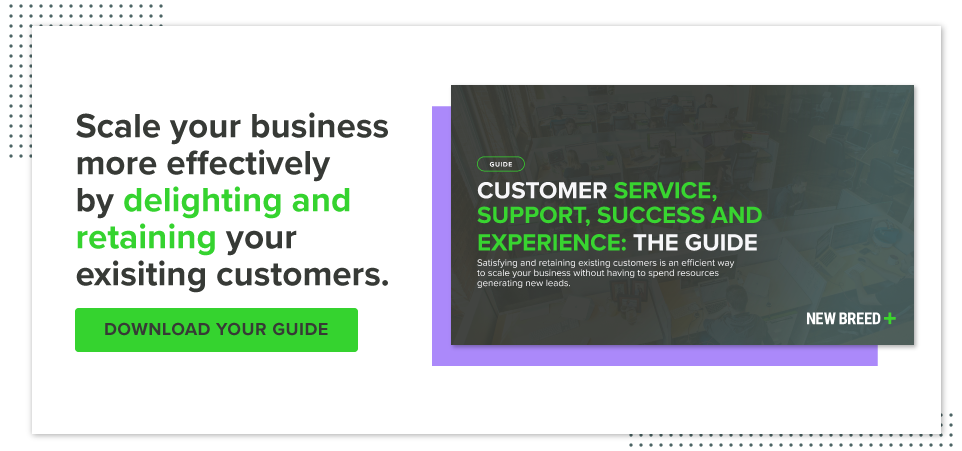How to Design a Customer Feedback Program

Customers are the lifeblood of any successful company, and providing them with value and a positive experience is essential to keeping them around. But how can you ensure you’re successfully meeting your customers’ needs? You have to collect customer feedback.
“The purpose of getting customer feedback of any sort, negative, positive, qualitative, quantitative, stuff you ask, stuff you didn’t — the whole purpose is just learning,” says Client Experience Lead Karin Krisher. “If you’re not learning about that experience, there’s just no way to improve it.”
Collecting customer feedback and leveraging it to improve experience is a cyclical process. You gather information, analyze it, implement actions based on the feedback and then continue to gather information over time to see if your actions made a difference.
To maximize the results you see from the process, you need to be intentional when developing your customer feedback program. If you never act on the information you gather then there’s no point gathering it in the first place. With that in mind, the first step of creating your customer feedback program is to determine what you hope to achieve — and learn — from it.
Set Your Goals
Leveraging feedback can impact many areas of your customers’ engagement with your company such as churn, renewals, customer lifetime value, referrals, customer health, customer satisfaction, customer experience and customer support needs. To know what information to collect, you need to know what specifically you’re trying to impact.
When it comes to customer feedback programs, there are two types of goals: goals for the program as a whole and goals for each feedback request.
Before you can set a goal, you also need to have a baseline to measure against. Your company should have information on churn, renewals and customer lifetime value, but if you don’t have a feedback function in place, you might not have information on things like customer experience or satisfaction. In that case, your first goal will likely be to develop a baseline.
Once you have a baseline, you should set SMART goals for each feedback request. When setting these goals, consider what your organization as a whole wants to achieve and then work backward from there.
For example, if your company’s goal is to enhance customer experience and you know based on reviews that product errors are a main cause of dissatisfaction, then you might want to collect product feedback and use it to make improvements with the goal of decreasing negative reviews by 20% in three months.
Goals can also come from informal feedback and your service and product team. In that example, existing feedback from reviews helped you determine where to dig deeper, but if you don’t have a resource like that available, you can develop a hypothesis based on your observations or ask your product or service team what they want to learn in order to better serve customers.
Identify Where Feedback Exists
Customer feedback doesn’t just come from formal surveys or reviews. It can also occur through behavior during meetings or how customers react to an experience
“It’s important to know where this feedback is already happening because you don’t just want answers to questions you’ve designed,” Karin says. “You also want to take a larger view of everything and observe the answers to questions you’re not asking.”
Once you have your goal and know what kind of feedback you’re looking for, the next step of developing a customer feedback program is to identify where feedback already exists.
“Out of the gate, attempt to enumerate all of the places where a customer could talk about you and think about whether it’s worth it to analyze feedback from those channels,” Karin says. “Figure out where in the customer lifecycle you’re collecting feedback already, whether it’s qualitative or quantitative, what questions you’re asking, what questions you could ask and the language around those.”
Karin recommends organizing that information in a customer experience map, which is a timeline of a customer’s engagement with you that includes touchpoints like onboarding, support requests, product usage, quarterly check-ins and contract renewals. Additionally, it can help you track sentiment and experience.
When analyzing your customer experience map, the gaps can be just as important as the peaks. While sentiment around major touchpoints like onboarding and renewal is important, what happens in between is the bulk of the customer experience.
What happens when they’re leveraging your product or service? What happens when they don’t? The gaps in the feedback you have can highlight opportunities to ask questions.
Collect New Feedback
As mentioned, the feedback you solicit should be based on your goals. Standardized surveys like customer satisfaction score, net promoter score and customer effort score can be used to understand satisfaction, likelihood to refer and the support experience and result in quantitative feedback. On the other hand, asking for written reviews or conducting interviews can provide you with qualitative feedback.
You can also establish frameworks for recording the less formal feedback that occurs. For example, you could create templates for members of your customer-facing team to fill out whenever they interact with a customer or you could conduct regular social media audits to understand how your customers are speaking about your company publicly.
Ensure Feedback is Utilized
The final aspect of a customer feedback program is leveraging the information gathered in order to improve customer experience overall. This requires both an intentionality around the feedback you collect and a commitment to ground new initiatives in customer feedback.
Whoever is running your customer feedback program should be accountable for presenting the results they gather to the relevant teams. On the other end, every new project that impacts your customers should have a checkpoint at the start requiring customer feedback to be taken into account.
Quinn Kanner
Quinn is a writer and copyeditor whose work ranges from journalism to travel writing to inbound marketing content.





